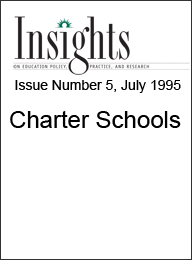Charter Schools: Early Learnings (Comparison of Charter School Legislation)
Introduction
The purpose of this Insights is to examine the concerns and difficulties charter schools are encountering in the early stages of planning and implementation. The empirical research that is beginning to emerge from charter sites in California, Colorado, and Minnesota provides some valuable lessons for policymakers, parents, and educators. The problems are highlighted not in an attempt to derail support for existing charter school policies, but rather to better inform those in the position of shaping and drafting future policies.
In response to the public's growing frustration with the pace and scope of school improvement, legislators, educators, and parents are increasingly turning to charter schools as the reform of choice. Viewed as a compromise between "throwing" additional dollars at the current system and moving dollars (and students) into the private sector with vouchers, charter schools are popular because they promise relatively cost-free innovation within the boundaries of the public system.
Over the last few years, the charter school movement has gained significant momentum in the U.S. In 1991, only one state, Minnesota, had passed charter school legislation. By 1994, a total of eleven states had enacted charter school laws. This year, at least 23 states, including Arkansas, Louisiana, and Texas, considered charter school bills and several enacted legislation.1 To date, more than 200 charters have been granted to schools in at least nine states (Walsh, 1995).
Next Page: Defining Charter Schools

